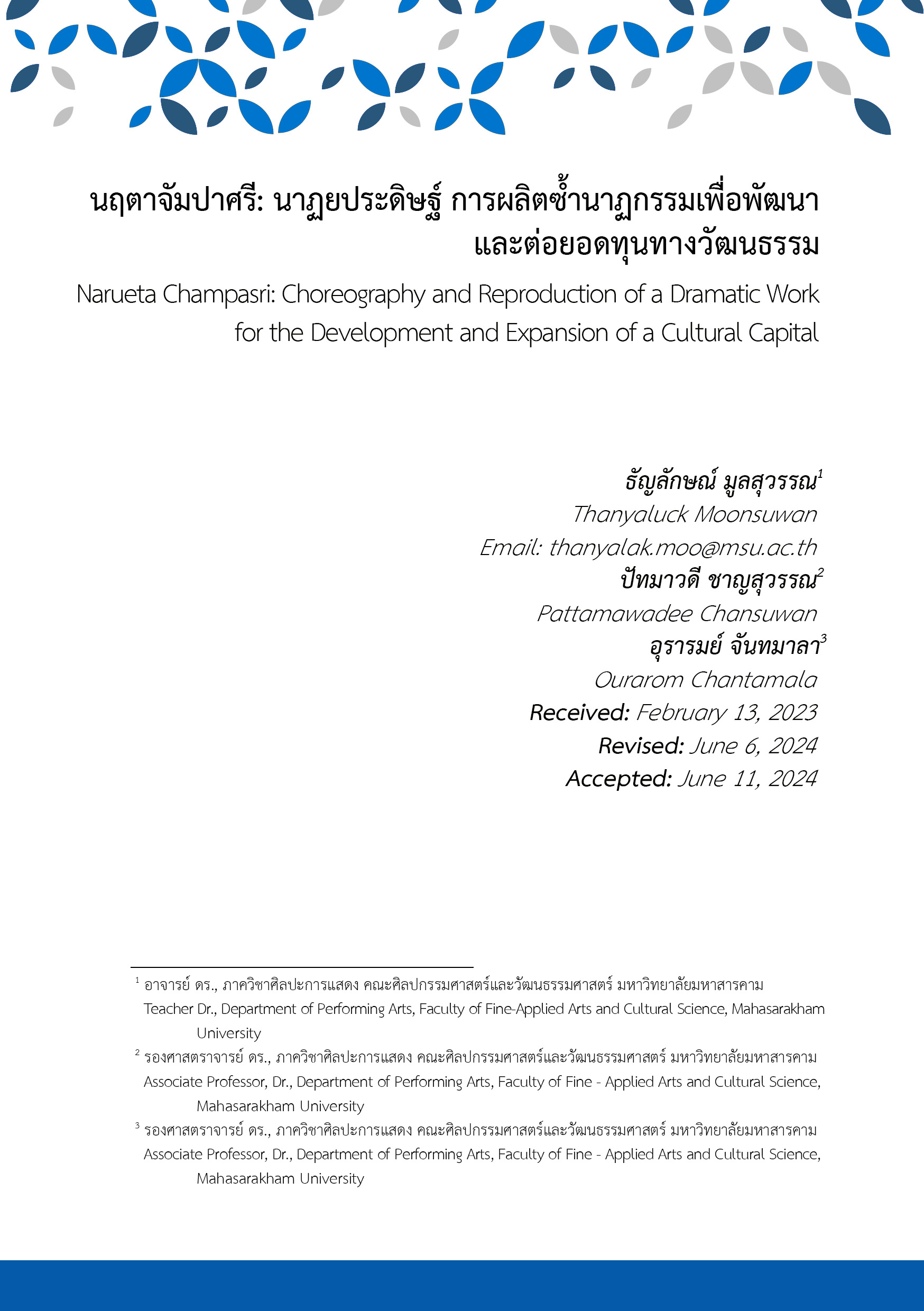Narueta Champasri: Choreography and Reproduction of a Dramatic Work for the Development and Expansion of a Cultural Capital นฤตาจัมปาศรี: นาฏยประดิษฐ์ การผลิตซ้ำนาฏกรรมเพื่อพัฒนา และต่อยอดทุนทางวัฒนธรรม
Main Article Content
Abstract
This research article aimed to study the process of creating worship dances at religious sites in the Northeast of Thailand and the process of creating the Narueta Champasri dance in terms of concepts, styles, dance moves, music, and costumes. The research was conducted by means of a qualitative research method through the interview process with 3 sample groups consisting of the key informant group, the casual informant group, and the general informant group. The research results found that 1) The process of creating worship dances at religious sites in the Northeast of Thailand arises from beliefs related to worshiping gods and sacred things and thus wherever a religious place was built, various rituals were often performed and they have been performed continuously since the days of their ancestors and have been passed down to future generations through the identity of Isan folk dances; 2) The process of the performance of “Narueta Champasri: Choreography and Reproduction of a Dramatic Work for the Development and Expansion of a Cultural Capital combines dance moves from unique images engraved on stone boundary markers of Buddhist temples. All of them originated from the local culture which has long been the basis of the lives of the Isan people. They have then been expanded into local performances featuring Isan traditional dance moves that reflect distinct identity. The melody used in the performance is the Phatcha and the costume imitates that of the Dvaravati period culture. It is an expansion of the cultural tradition of worshiping a religious location originated from the belief in the worship of gods and sacred things of the Isan people. This reflects the Buddhist faith related to Phra Borommathat Na Dun, which was incorporated in the creation of the “Narueta Champasri” dance through the application of worship dance poses. This cultural reproduction is intended to be easily understood by the audience in order to generate an awareness of the value of performing arts wisdom. It is another strategy to increase the number of people who pay homage to the Buddha’s relics.
Downloads
Article Details

This work is licensed under a Creative Commons Attribution-NonCommercial-NoDerivatives 4.0 International License.
References
College of Dramatic Arts. (2010). Dance the Goddess with a pair of Bags. Conservative Creative Research, Bunditpatanasilpa Institute.
Kaewthep, K. and Hinvima, S. (2008). Stream of political economic theory thinkers and educational media. Bangkok: Parbpim Printing.
Levy, D. L. (2000). Applications and Limitations of Complexity Theory in Organization Theory and Strategy. Joachim: KieferleErwin Herzberger.
Phanmanee, A. (2004). Creativity. Bangkok: 1412 publisher. The Fine Arts Department. (1970). Memoirs of Relationship between Thailand and Other Countries in the 17Th Century. Bangkok: The Fine Arts Department.
Wirunrak, S. (2004). Principles of periscope dance performance. Bangkok: Chulalongkorn University.
Thepwong, S. (2005). Thai Dance: For Elementary-Higher Education Teachers. Bangkok: Odeonstore
Williams, R. (1965). The Long Revolution. Pelican: Penguin Books.


